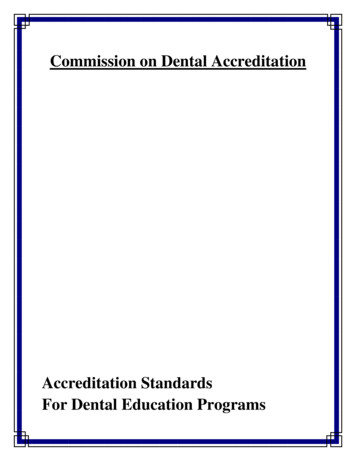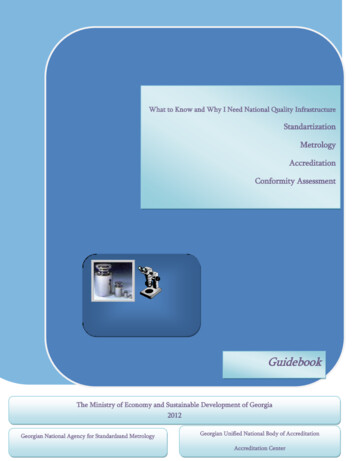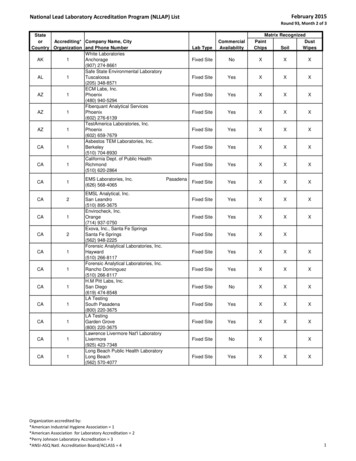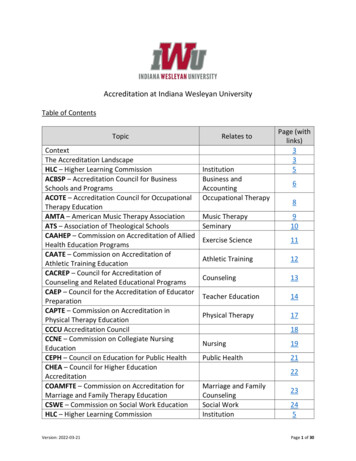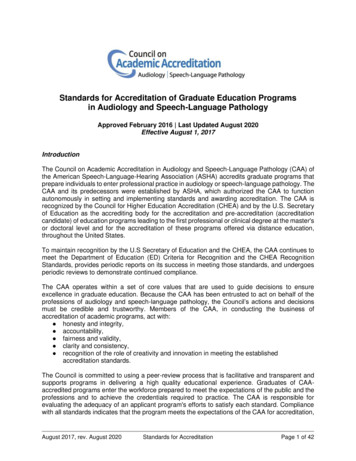
Transcription
Standards for Accreditation of Graduate Education Programsin Audiology and Speech-Language PathologyApproved February 2016 Last Updated August 2020Effective August 1, 2017IntroductionThe Council on Academic Accreditation in Audiology and Speech-Language Pathology (CAA) ofthe American Speech-Language-Hearing Association (ASHA) accredits graduate programs thatprepare individuals to enter professional practice in audiology or speech-language pathology. TheCAA and its predecessors were established by ASHA, which authorized the CAA to functionautonomously in setting and implementing standards and awarding accreditation. The CAA isrecognized by the Council for Higher Education Accreditation (CHEA) and by the U.S. Secretaryof Education as the accrediting body for the accreditation and pre-accreditation (accreditationcandidate) of education programs leading to the first professional or clinical degree at the master'sor doctoral level and for the accreditation of these programs offered via distance education,throughout the United States.To maintain recognition by the U.S Secretary of Education and the CHEA, the CAA continues tomeet the Department of Education (ED) Criteria for Recognition and the CHEA RecognitionStandards, provides periodic reports on its success in meeting those standards, and undergoesperiodic reviews to demonstrate continued compliance.The CAA operates within a set of core values that are used to guide decisions to ensureexcellence in graduate education. Because the CAA has been entrusted to act on behalf of theprofessions of audiology and speech-language pathology, the Council’s actions and decisionsmust be credible and trustworthy. Members of the CAA, in conducting the business ofaccreditation of academic programs, act with: honesty and integrity, accountability, fairness and validity, clarity and consistency, recognition of the role of creativity and innovation in meeting the establishedaccreditation standards.The Council is committed to using a peer-review process that is facilitative and transparent andsupports programs in delivering a high quality educational experience. Graduates of CAAaccredited programs enter the workforce prepared to meet the expectations of the public and theprofessions and to achieve the credentials required to practice. The CAA is responsible forevaluating the adequacy of an applicant program's efforts to satisfy each standard. Compliancewith all standards indicates that the program meets the expectations of the CAA for accreditation,August 2017, rev. August 2020Standards for AccreditationPage 1 of 42
regardless of mode of delivery, including distance education. The CAA evaluates programs toensure that there is equivalence across all modes of delivery, that students enrolled in distanceeducation or other modes of education delivery are held to the same standards as students inresidential programs, and that students enrolled in all modes of education are afforded equalaccess to all aspects of the education program, including courses, clinical practicum opportunities,supervision, advising, student support services, and program resources.Accreditation by the CAA indicates that a program is committed to excellence and ongoing qualityimprovement so that students and the public are assured that graduates are prepared to meetthe challenges they will face when entering the workforce.PreambleThe CAA recognizes that programs are responding to a range of pressures from within theirinstitutions (e.g., to increase enrollment) and outside the institutions (e.g., to provide moreemployment-ready, highly educated professionals to fill the vast need for practitioners). Not onlyis there a demand for more professionals, but—in the changing health care and educationalarenas—these new professionals are expected to be able to function in complex, interdisciplinary,and collaborative models of service delivery. They also must be prepared to meet the need toprovide efficacious service based on a strong base of evidence to all individuals who seek theservices of audiologists and speech-language pathologists. Further, they must have at leastintroductory preparation to provide clinical education to future professionals.The Council recognizes the diversity of models of educational delivery, institutions providing theseprograms, and missions of the education programs. At the same time, the CAA is committed toexcellence in educational preparation, while assuring the public that graduates of accreditedprograms possess a core set of knowledge and skills necessary to qualify for state and nationalcredentials for independent professional practice. Further, the CAA acknowledges that there aredistinct sets of knowledge and skills and methods of service delivery required of individuals whowill become audiologists or speech-language pathologists and, thus, has different expectationswith regard to the curricular elements of the programs that educate future audiologists andspeech-language pathologists.Understanding the impact of these many challenges, the CAA designed the accreditationstandards to ensure the provision of high quality educational experiences. These standards arenot prescriptive because the CAA values the variety of ways that high quality education can beachieved. The standards and each program’s implementation of them should allow forconsistency in the quality of graduates from the accredited programs. At the same time, eachprogram should be innovative, flexible, and creative in meeting the standards, in congruence withits individual mission and goals.To that end, the accreditation standards have been written to address six essential components.The standards are designed to ensure that, when programs are in full compliance, their graduatestudents are prepared to function in the complex and ever-changing service provision (or delivery)arenas. The components are: Standard 1.0: Administrative structure and governanceStandard 2.0: FacultyStandard 3.0A: Curriculum (academic and clinical education) for audiology programsAugust 2017, rev. August 2020Standards for AccreditationPage 2 of 42
Standard 3.0B: Curriculum (academic and clinical education) for speech-languagepathology programsStandard 4:0StudentsStandard 5:0AssessmentStandard 6:0Program resourcesStandards for accreditation appear in bold. Following each standard, the Requirement forReview provides interpretations or explanations of the standard.A Glossary is provided following the standards with definitions to assist in interpreting theaccreditation standards.CitationCite as: Council on Academic Accreditation in Audiology and Speech-Language Pathology.(2020). Standards for accreditation of graduate education programs in audiology andspeech-language pathology (2017). Retrieved [date] ation-standards-for-graduate-programs.pdfAugust 2017, rev. August 2020Standards for AccreditationPage 3 of 42
Standard 1.0 Administrative Structure and Governance1.1 The sponsoring institution of higher education holds current regional accreditation.Requirement for Review: The institution of higher education within which the audiology and/or speech-languagepathology program is housed must hold regional accreditation from one of the followingregional accrediting bodies:o Middle States Commission on Higher Education;o New England Association of Schools and Colleges, Commission on Institutionsof Higher Education;o North Central Association of Colleges and Schools, The Higher LearningCommission;o Northwest Commission on Colleges and Universities;o Southern Association of Colleges and Schools, Commission on Colleges;o Western Association of Schools and Colleges, Accrediting Commission forSenior Colleges and Universities.1.2 The sponsoring institution of higher education must be authorized to provide theprogram of study in audiology and/or speech-language pathology.Requirement for Review: The sponsoring institution of higher education must be authorized under applicable lawsor other acceptable authority to provide the program of post-secondary education. The sponsoring institution of higher education must have appropriate graduate degreegranting authority.1.3 The program has a mission and goals that are consistent with preparation of studentsfor professional practice.Requirement for Review: The mission statement and the goals of the program (including religious mission, ifrelevant) must be presented. The program must describe how the mission statement and program goals are used toguide decision making to prepare students for entry level into professional practice inaudiology or speech-language pathology.1.4 The program faculty must regularly evaluate the congruence of program andinstitutional missions and the extent to which the goals are achieved.Requirement for Review: The program monitors its mission and goals to ensure that they remain congruent withthose of the institution. The program periodically reviews and revises its mission and goals. The program systematically evaluates its progress toward fulfillment of its mission andgoals.August 2017, rev. August 2020Standards for AccreditationPage 4 of 42
1.5 The program develops and implements a long-term strategic plan.Requirement for Review: The plan must be congruent with the mission and goals of the program and thesponsoring institution, have the support of the administration, and reflect the role of theprogram within its community. The plan identifies long-term goals, specific measurable objectives, strategies forattainment of the goals and objectives, and a schedule for analysis of the plan. The plan must include a mechanism for regular evaluation of the plan itself and ofprogress in meeting the plan’s objectives. An executive summary of the strategic plan or the strategic plan must be shared withfaculty, students, staff, alumni, and other interested parties.1.6 The program’s faculty has authority and responsibility for the program.Requirement for Review: The institution’s administrative structure demonstrates that the program’s faculty isrecognized as the body that can initiate, implement, and evaluate decisions affecting allaspects of the professional education program, including the curriculum. The program faculty has reasonable access to higher levels of administration.1.7 The individual responsible for the program of professional education seekingaccreditation holds a graduate degree with a major emphasis in speech-languagepathology, in audiology, or in speech, language, and hearing science and holds a fulltime appointment in the institution.Requirement for Review: The individual designated as program director holds a graduate degree with a majoremphasis in speech-language pathology, in audiology, or in speech, language, andhearing science The individual designated as program director holds a full-time appointment in theinstitution.1.8 The institution and program must comply with all applicable laws, regulations, andexecutive orders prohibiting discrimination towards students, faculty, staff, and personsserved in the program’s clinics. This includes prohibitions on discrimination based onany category prohibited by applicable law but not limited to age, citizenship, disability,ethnicity, gender identity, genetic information, national origin, race, religion, sex, sexualorientation, and veteran status.Requirement for Review: The institution and program must comply with all applicable federal, state, and locallaws, regulations, and executive orders prohibiting discrimination, including laws thatprohibit discrimination based on age, citizenship, disability, ethnicity, gender identity,genetic information, national origin, race, religion, sex, sexual orientation, and veteranstatus.The program must adhere to its institutional policies and procedures—including non-harassment policies, internal complaint procedures, and appropriate educationalprograms—to ensure that the program complies with all applicable nondiscriminationAugust 2017, rev. August 2020Standards for AccreditationPage 5 of 42
statutes and that all staff, faculty, and students are made aware of the policies and theconduct they prohibit.The program must maintain, as relevant, a record of internal and external complaints,charges, and litigation alleging violations of such policies and procedures and ensurethat appropriate action has been taken.1.9 The program provides information about the program and the institution to studentsand to the public that is current, accurate, and readily available.Requirement for Review: The program must publish to the general public on its website the program’s CAAaccreditation status, in accordance with the language specified in the Public Notice ofAccreditation Status in the CAA Accreditation Handbook, as required under federalregulations. This must be displayed in a clearly visible and readily accessible location.Additional references to the program’s accreditation status must be accurate but neednot include all components of the accreditation statement.Websites, catalogs, advertisements, and other publications/electronic media must beaccurate regarding standards and policies regarding recruiting and admission practices,academic offerings, matriculation expectations, academic calendars, grading policiesand requirements, and fees and other charges.The program must make student outcome measures available to the general public byposting the results on the program’s website via a clearly visible and readily accessiblelink.The program must make public the number of expected terms for program completionfor full-time and part-time students.At a minimum, the following results of student outcome measures for the most recentlycompleted 3 academic years must be provided:o number and percentage of students completing the program within the program’spublished time frame for each of the 3 most recently completed academic years,o number and percentage of program test-takers who pass the Praxis SubjectAssessment examination for each of the 3 most recently completed academic years(programs need report only the results once for test-takers who take the test morethan one time in the reporting period),o number and percentage of program graduates employed in the profession orpursuing further education in the profession within 1 year of graduation for each ofthe 3 most recently completed academic years.Student outcome measures must be labeled “Student Achievement Data” or “StudentOutcome Data.”o If both the audiology and the speech-language programs are accredited, separatedata tables must be provided for each program.o If the program has a distance education component or a satellite campus, thestudent outcome data must be presented for each modality.August 2017, rev. August 2020Standards for AccreditationPage 6 of 42
Standard 2.0 Faculty2.1 The number and composition of the program faculty (academic doctoral, clinicaldoctoral, other) are sufficient to deliver a program of study that:2.1.1 allows students to acquire the knowledge and skills required in Standard 3,2.1.2 allows students to acquire the scientific and research fundamentals of thediscipline,2.1.3 allows students to meet the program’s established goals and objectives,2.1.4 meets the expectations set forth in the program’s mission and goals,2.1.5 is offered on a regular basis so that it will allow the students to complete theprogram within the published time frame.Requirement for Review: The program must documento the number of individuals in and composition of the group that delivers theprogram of study;o the distribution of faculty in terms of the number of full-time and part-timeindividuals who hold academic doctoral degrees, clinical doctoral degrees, andmaster’s degrees;o how the faculty composition is sufficient to allow students to acquire theknowledge and skills required in Standard 3;o how the faculty composition is sufficient to allow students to acquire the scientificand research fundamentals of the profession;o how the faculty composition is sufficient to allow students to meet the program’sestablished learning goals and objectives;o how the faculty composition is sufficient to allow students to meet theexpectations set forth in the program’s mission and goals;o how the faculty composition ensures that the elements (classes and clinicalpractica) of the program are offered on a regular basis so that students cancomplete the program within the published time frame.2.2 The number, composition, and workload of all full-time faculty who haveresponsibility in the graduate program are sufficient to allow them to meet expectationswith regard to teaching, research, and service of the sponsoring institution.Requirement for Review: The program must demonstrate that all faculty who have responsibility in the graduateprogram and have obligations to provide teaching, research, and service as part of theirworkloado are accessible to students,o have sufficient time for scholarly and creative activities,o have sufficient time to advise students,o have sufficient time to participate in faculty governance,o have sufficient time to participate in other activities that are consistent with theexpectations of the sponsoring institution. The program must demonstrate that all faculty who have responsibility in the graduateprogram and have obligations to provide clinical education and service as part of theirworkloado are accessible to students,August 2017, rev. August 2020Standards for AccreditationPage 7 of 42
oooo have sufficient time for scholarly and creative activities,have sufficient time to advise students,have sufficient time to participate in faculty governance,have sufficient time to participate in other activities that are consistent with theexpectations of the sponsoring institution.The program must demonstrate that faculty who are tenure eligible have the opportunityto meet the criteria for tenure of the sponsoring institution.The program must demonstrate that faculty who are eligible for promotion have theopportunity to meet the criteria for promotion of the sponsoring institution.The program must demonstrate that faculty who are eligible for continuing employmenthave the opportunity to meet the expectations for continued employment of thesponsoring institution.2.3 All faculty members (full-time, part-time, adjuncts), including all individuals providingclinical education, are qualified and competent by virtue of their education, experience,and professional credentials to provide academic and clinical education as assigned bythe program leadership.Requirement for Review: The program must demonstrate that the qualifications and competence to teachgraduate-level courses and to provide clinical education are evident in terms ofappropriateness of degree level, practical or educational experiences specific toresponsibilities in the program, and other indicators of competence to offer graduateeducation. The program must demonstrate that all individuals providing didactic and clinicaleducation, both on-site and off-site, have appropriate experience and qualifications forthe professional area in which education is provided. The program must demonstrate that the faculty possess appropriate qualifications andexpertise to provide the depth and breadth of instruction for the curriculum as specifiedin Standard 3. The program must demonstrate that the majority of academic content is taught bydoctoral faculty who hold the appropriate terminal academic degree (PhD, EdD).2.4 All faculty members maintain continuing competence and demonstrate pursuit oflifelong learning.Requirement for Review: The program must demonstrate that all individuals who have responsibility to deliveracademic and clinical components of the graduate program maintain continuingcompetence. The program must demonstrate that all individuals who have responsibility to deliver thegraduate program pursue lifelong learning.August 2017, rev. August 2020Standards for AccreditationPage 8 of 42
Standard 3.0A Curriculum (Academic and Clinical Education) in Audiology3.1A An effective entry-level professional audiology program allows each student toacquire knowledge and skills in sufficient breadth and depth to enable the student tofunction as an effective, well-educated, and competent clinical audiologist (i.e., one whocan practice within the full scope of practice of audiology). The education program isdesigned to afford each student with opportunities to meet the expectations of theprogram that are consistent with the program’s mission and goals and that prepare eachstudent for independent professional practice as an audiologist.Requirement for Review:The doctoral program in audiology must meet the following requirements. Provide evidence of a curriculum that allows students to achieve the knowledge and skillslisted below. Typically, the achievement of these outcomes requires the completion of 4years of graduate education or the equivalent. Include a minimum of 12 months' full-time equivalent of supervised clinical experiences.These include short-term rotations and longer term externships and should be distributedthroughout the program of study. Establish a clear set of program goals and objectives that must be met for students toacquire the knowledge and skills needed for entry into independent professionalpractice. Establish a clear process to evaluate student achievement of the program’s establishedobjectives. Offer opportunities for each student to acquire the knowledge and skills needed for entryinto independent professional practice, consistent with the scope of practice foraudiology, and across the range of practice settings. Offer a plan of study that encompasses the following domains:o professional practice competencies;o foundations of audiology practice;o identification and prevention of hearing loss, tinnitus, and vestibular disorders;o assessment of the structure and function of the auditory and vestibular systems;o assessment of the impact of changes in the structure and function of the auditoryand vestibular systems;o intervention to minimize the effects of changes in the structure and function of theauditory and vestibular systems on an individual’s ability to participate in his orher environment. Offer high quality learning environments that are learner centered, knowledge and skillcentered, and assessment centered. Offer the academic and clinical program on a regular basis so that students are able tosatisfy degree and other requirements within the published time frame. Offer opportunities to qualify for state and national credentials that are required for entryinto independent professional practice that are consistent with the program mission andgoals.3.1.1A Professional Practice CompetenciesThe program must provide content and opportunities for students to learn so that eachstudent can demonstrate the following attributes and abilities and demonstrate thoseattributes and abilities in the manners identified.August 2017, rev. August 2020Standards for AccreditationPage 9 of 42
Accountability Practice in a manner that is consistent with the professional codes of ethics andthe scope of practice documents for the profession of audiology. Adhere to federal, state, and institutional regulations and policies that are relatedto care provided by audiologists. Understand the professional’s fiduciary responsibility for each individual served. Understand the various models of delivery of audiologic services (e.g., hospital,private practice, education, etc.). Use self-reflection to understand the effects of his or her actions and makechanges accordingly. Understand the health care and education landscapes and how to facilitateaccess to services. Understand how to work on interprofessional teams to maintain a climate ofmutual respect and shared values.Integrity Use the highest level of clinical integrity with each individual served, familymembers, caregivers, other service providers, students, other consumers, andpayers. Understand and use best professional practices as they relate to maintenance ofconfidentiality for all individuals in accordance with requirements of the HealthInsurance Portability and Accountability Act (HIPAA) and the Family EducationalRights and Privacy Act (FERPA).Effective Communication Skills Use all forms of expressive communication—including written, spoken, andnonverbal communication—with individuals served, family members, caregivers,and any others involved in the interaction to ensure the highest quality of carethat is delivered in a culturally competent manner. Communicate—with patients, families, communities, interprofessional teamcolleagues, and other professionals caring for individuals—in a responsive andresponsible manner that supports a team approach to maximize care outcomes.Clinical Reasoning Use valid scientific and clinical evidence in decision making regardingassessment and intervention. Apply current knowledge, theory, and sound professional judgment inapproaches to intervention and management of individuals served. Use clinical judgment and self-reflection to enhance clinical reasoning.Evidence-Based Practice Access sources of information to support clinical decisions regarding assessmentand intervention and management. Critically evaluate information sources and apply that information to appropriatepopulations. Integrate evidence in the provision of audiologic services.Concern for Individuals Served Show evidence of care, compassion, and appropriate empathy duringinteractions with each individual served, family members, caregivers, and anyothers involved in care. Encourage active involvement of the individual in his or her own care.August 2017, rev. August 2020Standards for AccreditationPage 10 of 42
Cultural Competence Understand the impact of his or her own set of cultural and linguistic variables ondelivery of effective care (these include, but are not limited to, variables such asage, ethnicity, linguistic background, national origin, race, religion, gender, andsexual orientation). Understand the impact of the cultural and linguistic variables of the individualsserved on delivery of effective care (these include, but are not limited to,variables such as age, ethnicity, linguistic background, national origin, race,religion, gender, and sexual orientation). Understand the interaction of cultural and linguistic variables between thecaregivers and the individual served in order to maximize service delivery. Understand the characteristics of the individuals served (e.g., age,demographics, cultural and linguistic diversity, educational history and status,medical history and status, cognitive status, physical and sensory abilities) andhow they relate to clinical services. Understand the role of manual and other communication systems and the use ofsign and spoken interpreters/transliterators and assistive technology to deliverthe highest quality care.Professional Duty Engage in self-assessment to improve his or her effectiveness in the delivery ofclinical services. Understand the roles and importance of professional organizations inadvocating for the rights of access to comprehensive audiologic services. Understand the role of clinical teaching and clinical modeling, as well assupervision of students and other support personnel. Understand the roles and importance of interdisciplinary/interprofessionalassessment and intervention and be able to interact and coordinate careeffectively with other disciplines and community resources. Understand and practice the principles of universal precautions to prevent thespread of infectious and contagious diseases. Understand and use the knowledge of one’s own role and the roles of otherprofessionals to appropriately assess and address the needs of the individualsand populations served.Collaborative Practice Understand how to apply values and principles of interprofessional teamdynamics. Understand how to perform effectively in different interprofessional team roles toplan and deliver care—centered on the individual served—that is safe, timely,efficient, effective, and equitable.3.1.2A Foundations of Audiology PracticeThe program includes content and opportunities to learn so that each student candemonstrate knowledge of the embryology, anatomy, and physiology of the auditory, vestibular, and related bodysystems; normal aspects of auditory and vestibular function across the lifespan; normal aspects of speech production and language function across the lifespan; normal aspects of speech perception across the lifespan;August 2017, rev. August 2020Standards for AccreditationPage 11 of 42
effects and role of genetics in auditory function, diagnosis, and management ofhearing loss;effects and role of genetics in vestibular function, diagnosis, and management ofvestibular disorders;effects of chemicals and other noxious elements on auditory and vestibularfunction;effects of pathophysiology on the auditory, vestibular, and related body systems;medical and surgical interventions that may be used to treat the results ofpathophysiology in these systems;interaction and interdependence of speech, language, and hearing in thediscipline of human communication sciences and disorders;effects of hearing loss on the speech and language characteristics of individualsacross the life span and the continuum of care;effects of hearing impairment on educational, vocational, social, and psychologicalfunction and, consequently, on full and active participation in life activities;physical characteristics and measurement of simple and complex acoustic stimuli;physical characteristics and measurement of non-acoustic stimuli (e.g., EEG,tactile, electrical signals);methods of biologic, acoustic, and electroacoustic calibration of clinical equipmentto ensure compliance with current American Natio
accreditation status, in accordance with the language specified in the Public Notice of Accreditation Status in the CAA Accreditation Handbook, as required under federal regulations. This must be displayed in a clearly visible and readily accessible location. Additional references to the program's accreditation status must be accurate but need







